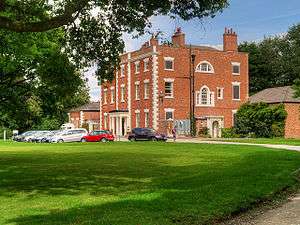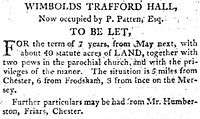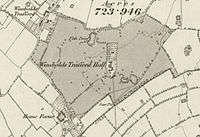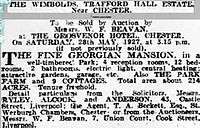Trafford Hall
Trafford Hall is a country house standing to the east of the village of Wimbolds Trafford, in Cheshire, England. It was built in 1756 for George Edward Gerrard. A ballroom was added in the 19th century.[1] As of 2011 the building is used as a hotel and conference centre,[2] and since 1995 has been the home of the charity the National Communities Resource Centre.[3] The house is constructed in brick with stone dressings and slate roofs.[4] Its architectural style is Georgian.[1] It has 2½ storeys and five bays on the entrance front.[5] To the left of the main block is a single-storey pavilion joined to the house by a service wing. To the right, and set back, is the ballroom.[1] The central bay of the main block projects slightly forward, and has rusticated quoins at the corners.[4] There are similar quoins at the corner of the house. In the central bay is a porch supported by four Doric columns. All the windows on the entrance front are sashes. On the right side of the house is a Venetian window in the second story, with a diocletian window above.[4] The interior contains a "fine staircase" with twisted balusters.[1] The house is recorded in the National Heritage List for England as a designated Grade II* listed building.[4]

George Edward Gerrard
George Edward Gerrard built Trafford Hall in 1756. He came from a family who had owned land in Wimbolds Trafford for over a century.[6] He was born in 1723 and in 1750 married Elizabeth Johnson who was the only daughter of George Johnson Esq. of Warrington.[7] The couple had three children, a son who died in infancy and two daughters. Unfortunately his wife Elizabeth died in 1766 at the age of 37. George became a Deputy Lieutenant of Cheshire and Justice of the Peace. He was well respected in the county. He died in 1794 and his eldest daughter Dorothy inherited Trafford Hall. As she had married the Reverend Richard Perryn twelve years earlier in 1782 he also became the owner and the property passed down through their descendants until the early 20th Century.
The Perryn family

Reverend Richard Perryn was born in 1754 in Standish, Cheshire. His father was Sir Richard Perryn a Welsh Judge who became Baron of the Exchequer. Richard was educated at Oxford University and became a clergyman. In 1779 he was appointed Rector of Standish by his father and he remained in this position for the next 45 years.[8] As he and Dorothy mainly lived in the Rectory at Standish during this time and Trafford Hall was rented to various tenants. Richard died in 1826 and his son Richard Gerrard Perryn (1791-1850) inherited the Hall.
Richard Gerrard Perryn was born in 1791 in Trafford Hall. In 1822 he married Harriet Barbara Hatfield the daughter of Alex Hatfield of Twickenham. Unlike his parents who rented Trafford Hall to tenants, Richard Gerrard Perryn lived there with his family for the rest of his life. He had five children, three sons and two daughters. When he died in 1850 his eldest son Gerrard Alexander Perryn (1824-1878) inherited the property.

Gerrard Alexander Perryn was born in 1824 in Trafford Hall. He was educated at Oxford and became a clergyman.[9] In 1857 he married Elizabeth Massey Wallis who was the daughter of Sir Provo William Parry Wallis, Admiral of the Fleet.[10] The couple had no children and when Gerrard died in 1878 he left Trafford Hall to his wife Elizabeth. She lived there with Gerrard’s unmarried sister Miss Harriet Perryn (1828-1906) until her death in 1890. Elizabeth died intestate and Trafford Hall therefore went to her next of kin which was her father Sir Provo William Wallis. He does not appear to have lived there as the 1891 Census shows that Miss Harriet Perryn was living there alone with the servants. In his Will of 1892 he left Trafford Hall to Harriet and the property therefore reverted to the Perryn family.[11]
Miss Harriet Perryn is the only member of the Perryn family to have lived at Trafford Hall from her birth until her death. She was born in 1828. When she inherited the house in 1892 she became Lady of the Manor and chief landowner of Wimbolds Trafford.[12] When she died in 1906 she left the property to her nephew Richard George Henry Perryn (1864-1927.[13]
Richard George Henry Perryn was born in 1864 in Lancashire. His father was Richard Henry Perryn (1832-1904), Harriet’s brother, and his mother was Frances Agnes White. In 1907 he married Frances Cotton Ashley who was the daughter of Henry Ashley of Yates Center, Kansas, USA.[14] The couple lived at Trafford Hall with their two daughters until about 1920.
Residents after 1920

The next resident was Arthur Washington Willmer.[15] He was a cotton broker from Liverpool and he lived at Trafford hall with his wife Janet and children until about 1927 when the house was put on the market. The sale advertisement is shown.
Arthur Barrington Hines (1889-1939) was a resident from about 1930.[16] He was a civil engineer and he lived here with his wife Martha until about 1938. After this Sir William Nicholas Cayzer and his family moved into Trafford Hall.[17]
Sir William Nicholas Cayzer (1910- 1999) (known as Nicholas) came from a wealthy family of shipowners. Their firm Cayzer, Irvine & Co is now called Clan Line. In 1935 he married Elizabeth Catherine Williams who came from Wales. Shortly after their marriage he moved to Trafford Hall and worked in the family’s shipping company offices in Liverpool. After the death of his uncle in 1958 he became Chairman of the Company.[18]
In 1957 the hall was sold to Francis Edward Hanning-Lee (known as Frank) and his wife Stella. A few years before they bought the Hall they were famous as they attempted a hydrofoil speed record in their boat called “White Hawk”. Their full story is told here. After this they decided to make fibre glass boats and they formed a company called Fibrelite Industries. Trafford Hall was used as the site of their manufacturing business.[19] They remained there until 1987. The Hall was sold in 1991 to the present occupants the National Communities Resource Centre who aims to provide training and support to all those living and working in low-income communities across the UK to develop their skills, confidence and capacity to tackle problems.
See also
References
- de Figueiredo, Peter; Treuherz, Julian (1988), Cheshire Country Houses, Chichester: Phillimore, pp. 275–277, ISBN 0-85033-655-4
- Welcome to Trafford Hall, Trafford Hall, retrieved 28 September 2015
- History of Trafford Hall, Trafford Hall, retrieved 28 September 2015
- Historic England, "Trafford Hall with attached service wing and carriage house (1145900)", National Heritage List for England, retrieved 25 September 2012
- Hartwell, Clare; Hyde, Matthew; Hubbard, Edward; Pevsner, Nikolaus (2011) [1971], Cheshire, The Buildings of England, New Haven and London: Yale University Press, p. 675, ISBN 978-0-300-17043-6
- The Genealogist, Vol. 30 1914, p. 207. Online reference
- Hanshall, j. H. 1817 “The History of the County Palatine of Chester”, p. 468. Online reference
- The History of the County Palatine and Duchy of Lancaster, Vol 4, 1891, p. 235. Online reference
- The County Families of the United Kingdom. Online reference
- FamilySearch website Gerrard Alexander Perryn. Online reference
- London Evening Standard - Monday 02 May 1892, p. 2.
- Kellys Directory 1896. Online reference
- Kellys Directory of Cheshire 1906.
- Kelly's Handbook to the Titled, Landed & Official Classes, 1913. Online reference
- Journal of the Royal Agricultural Society of England, 1921. Online reference
- List of Principal Seats in Cheshire, 1934. Online reference
- British Phone Book for Chestershire 1938 and “The Directory of Shipowners, Shipbuilders, and Marine Engineers” 1947. Online reference
- Cayzer family online archive. Online reference
- New Scientist, 6 April 1961. Online reference